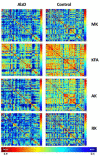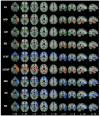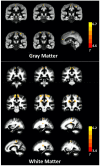Diffusion Magnetic Resonance Imaging-Based Biomarkers for Neurodegenerative Diseases
- PMID: 34069159
- PMCID: PMC8155849
- DOI: 10.3390/ijms22105216
Diffusion Magnetic Resonance Imaging-Based Biomarkers for Neurodegenerative Diseases
Abstract
There has been an increasing prevalence of neurodegenerative diseases with the rapid increase in aging societies worldwide. Biomarkers that can be used to detect pathological changes before the development of severe neuronal loss and consequently facilitate early intervention with disease-modifying therapeutic modalities are therefore urgently needed. Diffusion magnetic resonance imaging (MRI) is a promising tool that can be used to infer microstructural characteristics of the brain, such as microstructural integrity and complexity, as well as axonal density, order, and myelination, through the utilization of water molecules that are diffused within the tissue, with displacement at the micron scale. Diffusion tensor imaging is the most commonly used diffusion MRI technique to assess the pathophysiology of neurodegenerative diseases. However, diffusion tensor imaging has several limitations, and new technologies, including neurite orientation dispersion and density imaging, diffusion kurtosis imaging, and free-water imaging, have been recently developed as approaches to overcome these constraints. This review provides an overview of these technologies and their potential as biomarkers for the early diagnosis and disease progression of major neurodegenerative diseases.
Keywords: Alzheimer’s disease; Parkinson’s disease; amyotrophic lateral sclerosis; biomarker; diffusion kurtosis imaging; diffusion tensor imaging; free-water imaging; neurite orientation dispersion and density imaging.
Conflict of interest statement
The authors declare no conflict of interest.
Figures















Similar articles
-
Advanced diffusion magnetic resonance imaging in patients with Alzheimer's and Parkinson's diseases.Neural Regen Res. 2020 Sep;15(9):1590-1600. doi: 10.4103/1673-5374.276326. Neural Regen Res. 2020. PMID: 32209758 Free PMC article. Review.
-
MR Biomarkers of Degenerative Brain Disorders Derived From Diffusion Imaging.J Magn Reson Imaging. 2020 Dec;52(6):1620-1636. doi: 10.1002/jmri.27019. Epub 2019 Dec 13. J Magn Reson Imaging. 2020. PMID: 31837086 Free PMC article. Review.
-
Principles of diffusion kurtosis imaging and its role in early diagnosis of neurodegenerative disorders.Brain Res Bull. 2018 May;139:91-98. doi: 10.1016/j.brainresbull.2018.01.015. Epub 2018 Jan 31. Brain Res Bull. 2018. PMID: 29378223 Review.
-
Whole brain analyses of age-related microstructural changes quantified using different diffusional magnetic resonance imaging methods.Jpn J Radiol. 2017 Oct;35(10):584-589. doi: 10.1007/s11604-017-0670-7. Epub 2017 Jul 26. Jpn J Radiol. 2017. PMID: 28748504
-
Neurite density imaging versus imaging of microscopic anisotropy in diffusion MRI: A model comparison using spherical tensor encoding.Neuroimage. 2017 Feb 15;147:517-531. doi: 10.1016/j.neuroimage.2016.11.053. Epub 2016 Nov 27. Neuroimage. 2017. PMID: 27903438
Cited by
-
Traveling Subject-Informed Harmonization Increases Reliability of Brain Diffusion Tensor and Neurite Mapping.Aging Dis. 2023 Nov 15;15(6):2770-2785. doi: 10.14336/AD.2023.1020. Aging Dis. 2023. PMID: 38029401 Free PMC article.
-
Retinal Alterations as Potential Biomarkers of Structural Brain Changes in Alzheimer's Disease Spectrum Patients.Brain Sci. 2023 Mar 8;13(3):460. doi: 10.3390/brainsci13030460. Brain Sci. 2023. PMID: 36979270 Free PMC article.
-
Microstructural alterations in white matter and related neurobiology based on the new clinical subtypes of Parkinson's disease.Front Neurosci. 2024 Aug 1;18:1439443. doi: 10.3389/fnins.2024.1439443. eCollection 2024. Front Neurosci. 2024. PMID: 39148522 Free PMC article.
-
Early and progressive dysfunction revealed by in vivo neurite imaging in the rNLS8 TDP-43 mouse model of ALS.Neuroimage Clin. 2022;34:103016. doi: 10.1016/j.nicl.2022.103016. Epub 2022 Apr 22. Neuroimage Clin. 2022. PMID: 35483133 Free PMC article.
-
Diffusion tensor imaging biomarkers and clinical assessments in amyotrophic lateral sclerosis (ALS) patients: an exploratory study.Ann Med Surg (Lond). 2024 Jul 23;86(9):5080-5090. doi: 10.1097/MS9.0000000000002332. eCollection 2024 Sep. Ann Med Surg (Lond). 2024. PMID: 39239063 Free PMC article.
References
Publication types
MeSH terms
Substances
Grants and funding
LinkOut - more resources
Full Text Sources
Medical

